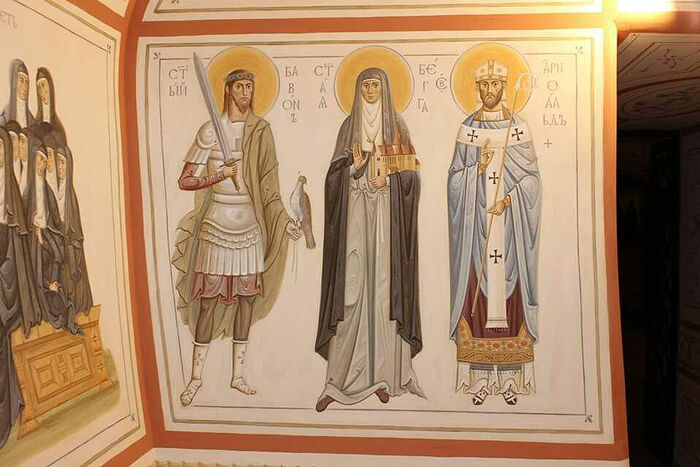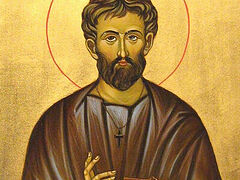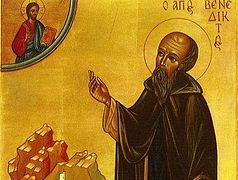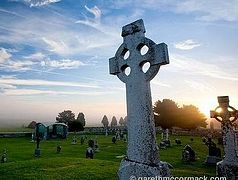Part 2: Missionaries and Enlighteners
We continue with an amazing series on the Orthodox saints of what is now call Benelux, by Matthew Hartley.
St. Bavo (Baaf) of Ghent (†c.653)
St. Foillan of Fosses (†c.655)
St. Winnoc of Wormhout (†c.716)
St. Plechelm of Odiliënberg (†730)
St. Meingold of Huy (†892)
We now turn to some of the great monastic figures of the Low Countries. As angels are a light to monks, so are monks a light to men, as St. John Climacus explained. The holy monks of this area are brilliant examples of this truth.
 Fresco icon depicting St. Bavo (Left) and St. Begga (Center)
Fresco icon depicting St. Bavo (Left) and St. Begga (Center)
One of the most celebrated monastic saints of this region is St. Bavo of Ghent. He was born into Austrasian nobility (Austrasia was the northeastern portion of the Frankish kingdom). His family was eminently characterized by holiness: His mother was St. Itta and his sisters were Sts. Begga and Gertrude (see below). Yet St. Bavo did not begin his life in an especially God-pleasing manner. Rather, he gave himself up to luxury and worldly living. He contracted an advantageous marriage; however, his wife’s death sometime later seems to have effected a profound change in the orientation of his life. Coming under the saintly influence of St. Amandus, he divested himself of all his worldly goods, distributing the proceeds to the poor. He accompanied St. Amandus in his mission work for a time, before retiring to an abbey built on his former property. There he passed his days as a hermit in the forest. He reposed in peace. His feast is celebrated on October first.
A few of the saints featured here originated from the British Isles. St. Foillan of Fosses, of Irish origin, is one of them. He, too, was part of a saintly family, counting among his brothers Sts. Ultan of Fosses and Fursey of Burgh Castle. Accompanying Fursey on his mission to East Anglia, where he served for a time as abbot of a monastery, he and Ultan were later forced to flee a pagan invasion. They traveled to Neustria, the western portion of the Frankish kingdom. Soon expelled from there as well, they proceeded to Nivelles in the Wallonia region. Here the saintly brothers were warmly received by Sts. Itta and Gertrude, who will be discussed below. St. Foillan was able to greatly enrich the establishment at Nivelles with the sacred treasures he had brought with him from his monastery in East Anglia. With their help he was able to establish a monastery nearby at Fosses-la-Ville. One day, having travelled to Nivelles to celebrate Mass for the feast of St. Quentin, St. Foillan and his companions were ambushed by bandits in the forest during their return journey and were killed. It is said that St. Foillan was still speaking prayers even after his head had been separated from his body. St. Gertrude later recovered and buried his holy relics.
 St. Winnoc of Wormhout St. Winnoc of Wormhout was similarly of British origin, coming from Wales (though he might instead have been Breton). He was apparently of noble birth, possibly the son of King St. Judicael of Brittany. St. Winnoc was apparently active in Cornwall for a time, founding a church there. He travelled to Flanders, where he seems to have spent the remainder of his days. After some time at the Abbey of Saint-Omer under the spiritual guidance of St. Berlin the Great (†c.709), he helped start a small monastic establishment at Wormhout, in French Flanders. He lived in great holiness; through his prayers, a mill ground grain automatically for the feeding of the brethren when the holy man had grown too old to operate it manually. He reposed in peace around the year 716.
St. Winnoc of Wormhout St. Winnoc of Wormhout was similarly of British origin, coming from Wales (though he might instead have been Breton). He was apparently of noble birth, possibly the son of King St. Judicael of Brittany. St. Winnoc was apparently active in Cornwall for a time, founding a church there. He travelled to Flanders, where he seems to have spent the remainder of his days. After some time at the Abbey of Saint-Omer under the spiritual guidance of St. Berlin the Great (†c.709), he helped start a small monastic establishment at Wormhout, in French Flanders. He lived in great holiness; through his prayers, a mill ground grain automatically for the feeding of the brethren when the holy man had grown too old to operate it manually. He reposed in peace around the year 716.
Still another saint of Irish origin warrants inclusion in this section. St. Plechelm hailed from Leinster, in the east of Ireland. Not much information seems to be available about his life. Nonetheless, he is considered one of the patron saints of the Netherlands. After laboring for a time in Northumbria in England, in company with St. Wiro (see below) he travelled to Frisia where they established an important monastery at Sint Odiliënberg in the southeastern Netherlands in the valley of the Roer River. Among other functions, this establishment provided crucial shelter to the Christian clergy of Utrecht during times of Viking assaults. St. Plechelm’s feast is July 15.
Finally, mention should be made in this section of St. Meingold of Huy. Little seems to be known about St. Meingold. He was apparently a count and knight of Huy on the Meuse River in the province of Liège in eastern Belgium. However, he turned at some point to the life of a penitent, presumably giving up his worldly status and associated wealth. He was murdered, it is said by political rivals, in 892 while returning from a pilgrimage. His relics, preserved in Huy, have been associated with numerous miracles.
These are just a sampling of the brilliant monastic saints and penitents who once illuminated this region of Europe with the radiance of their holiness.
To be continued…



